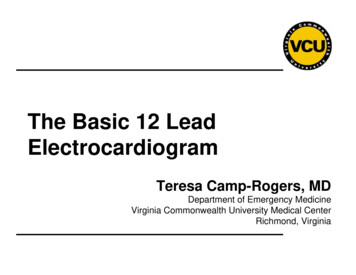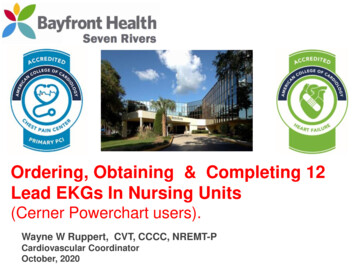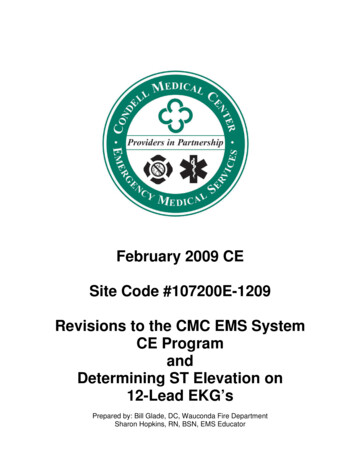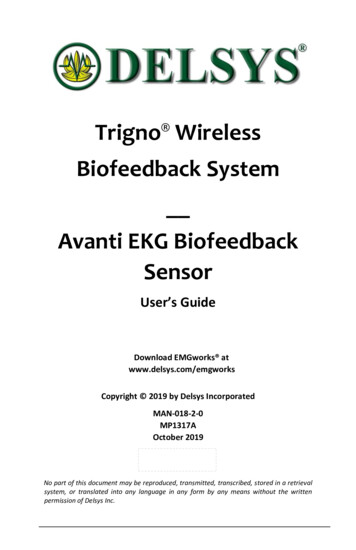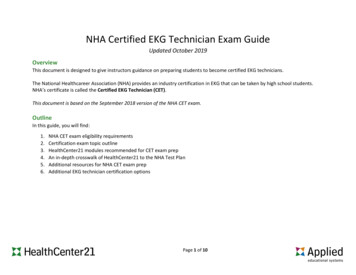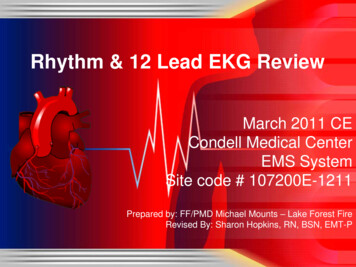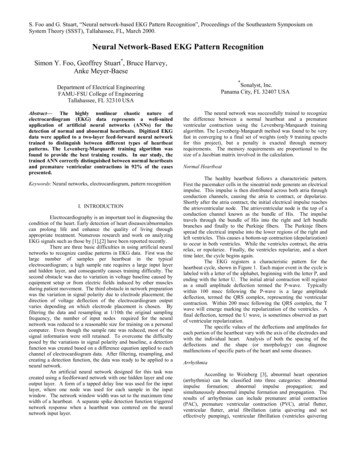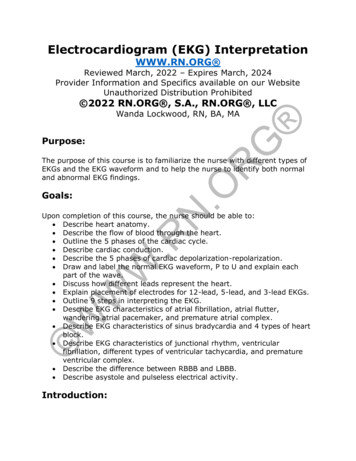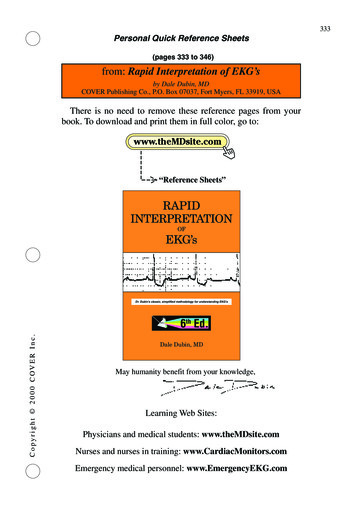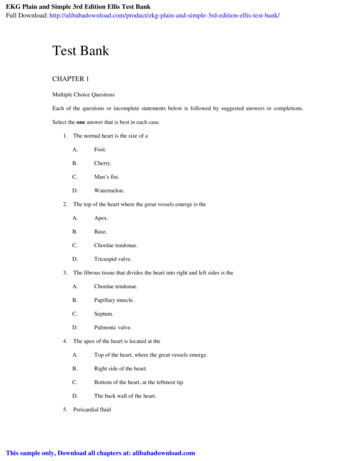
Transcription
EKG Plain and Simple 3rd Edition Ellis Test BankFull Download: imple-3rd-edition-ellis-test-bank/Test BankCHAPTER 1Multiple Choice QuestionsEach of the questions or incomplete statements below is followed by suggested answers or completions.Select the one answer that is best in each case.1.2.3.4.5.The normal heart is the size of aA.Foot.B.Cherry.C.Man’s fist.D.Watermelon.The top of the heart where the great vessels emerge is theA.Apex.B.Base.C.Chordae tendonae.D.Tricuspid valve.The fibrous tissue that divides the heart into right and left sides is theA.Chordae tendonae.B.Papillary muscle.C.Septum.D.Pulmonic valve.The apex of the heart is located at theA.Top of the heart, where the great vessels emerge.B.Right side of the heart.C.Bottom of the heart, at the leftmost tip.D.The back wall of the heart.Pericardial fluidThis sample only, Download all chapters at: alibabadownload.com
6.7.8.9.A.Decreases friction of the pericardial layers as they rub against each other.B.Prevents backflow of blood from one chamber to the other.C.Circulates through the heart’s chambers.D.Lubricates the electrical system of the heart.The innermost layer of the heart is ardium.The layer of the heart that is damaged during a heart attack is ardium.Which of these statements about the pericardium is NOT TRUE?A.It anchors the heart to the diaphragm and great vessels.B.It is a two-layer sac enclosing the heart.C.It serves as protection for the heart.D.It is the wall of the heart that is damaged in a heart attack.Which of the following statements about the right atrium is true?A.It is a receiving chamber for oxygenated blood returning from the lungs.B.It is the major pumping chamber of the heart.C.It is about 100% saturated with oxygen.D.It is the receiving chamber for deoxygenated blood coming from the vena cava.10. Which heart chamber delivers oxygenated blood to the entire body?A.Right atriumB.Right ventricleC.Left atrium
D.Left ventricle11. The heart’s valves open and close in response to changes inA.Oxygenation.B.Sodium and potassium concentration.C.Pressure.D.The heart’s pacemaker.12. Heart valves serve what purpose?A.They prevent blood from flowing forward.B.They prevent oxygenated blood from flowing through the coronary arteries.C.They prevent backflow of blood.D.They control the heart’s electrical signals.13. The valve that separates the right atrium and right ventricle is theA.Mitral valve.B.Pulmonic valve.C.Aortic valve.D.Tricuspid valve.14. The heart valve found at the opening of the pulmonary artery is theA.Aortic valve.B.Tricuspid valve.C.Mitral valve.D.Pulmonic valve.15. Which of the following are both AV valves?A.Tricuspid and mitral valvesB.Aortic and mitral valvesC.Mitral and pulmonic valvesD.Aortic and pulmonic valves16. The first heart sound (S1) is associated with closure of which heart valves?A.Mitral and aortic
B.Tricuspid and pulmonicC.Tricuspid and mitralD.Aortic and pulmonic17. The second heart sound (S2) is associated with closure of which heart valves?A.Mitral and aorticB.Tricuspid and pulmonicC.Tricuspid and mitralD.Aortic and pulmonic18. The structure that prevents backflow of blood is theA.Trebeculae carnae.B.Superior vena cava.C.Papillary muscle.D.Valve.19. What causes heart sounds?A.Blood traveling through the heartB.Opening of the heart valvesC.Closing of the heart valvesD.Blood hitting an obstruction in the peripheral circulation20. Through which structure must the blood travel in order to leave the right ventricle?A.Right atriumB.Tricuspid valveC.Left ventricleD.Pulmonic valve21. Which valves open to allow the ventricles to fill?A.Aortic and pulmonicB.Tricuspid and pulmonicC.Tricuspid and mitralD.Aortic and mitral
22. The inferior vena cava returns deoxygenated blood to the heart fromA.The head and neck.B.The coronary circulation.C.The lower extremities and abdomen.D.None of these—the vena cava carries oxygenated blood.23. Through which vessel does oxygenated blood enter the capillaries?A.AortaB.VeinsC.VenulesD.Arterioles24. Which of the following is the correct sequence of blood flow through the peripheral circulation?A.Arteries–veins–vena aries–venules– �� arteriesD.Capillaries–arterioles and venules–arteries and veins25. Pulmonary veins deliver blood to theA.Right atrium.B.Left atrium.C.Right ventricle.D.Left ventricle.26. The vessel that delivers oxygenated blood to the capillary bed is theA.Artery.B.Vein.C.Arteriole.D.Venule.27. The coronary circulation supplies oxygenated blood to the myocardium duringA.Ventricular ejection.B.Diastole.
C.The entire cardiac cycle.D.Isovolumetric contraction.28. The cardiac cycle’s two phases areA.Systole and diastole.B.Isovolumetric relaxation and contraction.C.Preload and afterload.D.Atrial kick and ventricular filling.29. The semilunar valves open when theA.Atrial pressure exceeds the ventricular pressure.B.Atrial and ventricular pressures are equal.C.Ventricular pressure exceeds the aortic and pulmonary arterial pressures.D.Impulse arrives at the AV node.30. The parasympathetic nervous system causesA.Slowed digestion.B.Decrease in heart rate.C.Pupillary dilation.D.Increase in blood pressure.True-False Questions1.T or F. The pericardium is the layer of the heart that is damaged during a heart attack.2.T or F. The heart chamber that has the greatest workload is the right atrium, as it pumps blood outto the entire body.3.T or F. The heart is composed primarily of muscle.4.T or F. The heart has three layers: the endocardium, myocardium, and epicardium.5.T or F. The layer of the heart that does the work of contracting is the endocardium.6.T or F. The pericardium is a double-walled sac that encloses the heart and serves as support andprotection.
7.T or F. The right atrium is a thin-walled receiving chamber for newly oxygenated blood from thelungs.8.T or F. The left atrium pumps blood into the right atrium.9.T or F. The heart’s top and bottom chambers are separated by valves that prevent backflow ofblood.10. T or F. The semilunar valves are the aortic and mitral valves.11. T or F. The job of the heart valves is to prevent backflow of blood.12. T or F. The vena cava is a large artery that carries blood from the right ventricle to the lungs.13. T or F. The three main coronary arteries are the aorta, the left main, and the chordae tendonae.14. T or F. The first phase of diastole is called the atrial kick, and it is the phase during which the atriafill with blood from the ventricles.15. T or F. The phase of systole that results in the greatest consumption of myocardial oxygen isisovolumetric contraction.Fill-in-the-Blank Questions1.The function of the heart is to .2.The normal amount of blood circulated by the heart every minute is liters.3.The is the layer that contains the cardiac conduction system.4.The fluid found between the layers of the pericardium is called .5.The is the chamber that receives blood from the superior and inferior venae cavae.6.The term means half-moon.7.The superior vena cava returns blood to the right atrium from the .8.The coronary artery that feeds blood to the right ventricle and the inferior wall of the left ventricleis the .9.The coronary artery that feeds blood to the lateral wall of the left ventricle is the .10. The two phases of the cardiac cycle are systole and .CHAPTER 2Multiple Choice Questions
Each of the questions or incomplete statements below is followed by suggested answers or completions.Select the one answer that is best in each case.1.2.3.4.5.6.What electrical event must occur for atrial kick to occur?A.Atrial depolarizationB.Ventricular depolarizationC.Atrial repolarizationD.Ventricular repolarizationThe cardiac cell at rest has what kind of electrical charge?A.Positive chargeB.Negative chargeC.Neutral chargeD.No charge at allThe EKG is a recording of theA.Heart’s mechanical activity.B.Brain’s electrical activity.C.Heart’s electrical activity.D.Heart’s electrical and mechanical activity.Depolarization is a(n)A.Electrical event that should result in muscle relaxation.B.Mechanical event that should result in depolarization.C.Electrical event that should result in muscle contraction.D.Mechanical event that should result in repolarization.Which of the following is NOT TRUE?A.Cardiac cells can contract without having been depolarized.B.Cardiac cells must be depolarized before they can contract.C.Cardiac contraction occurs as a result of phase 0 of the action potential.D.Cardiac contraction requires the presence of calcium ions.Which of the following ions has a direct effect on the strength of cardiac contraction?
7.8.9.A.SodiumB.PotassiumC.MagnesiumD.CalciumIn the action potential, phase 0 isA.Depolarization.B.Plateau.C.Rapid repolarization.D.Rest.In the action potential, phase 3 isA.Depolarization.B.Rapid repolarization.C.Plateau.D.Rest.Phase 0 of the action potential corresponds with what wave or complex on the EKG?A.T waveB.QRS complexC.U waveD.ST segment10. 20 mV is theA.Resting transmembrane potential.B.Transmembrane potential at the conclusion of phase 3 of the action potential.C.Transmembrane potential at the conclusion of phase 0 of the action potential.D.Transmembrane potential at the beginning of cardiac rest.11. Which of the following correctly describes the relative refractory period?A.It is the period in which even a weak impulse can cause another depolarization.B.It is the period in which only a strong impulse can cause another depolarization.C.It is the period in which no impulses at all can cause another depolarization.
D.It is the period in which the heart function stops temporarily to allow impulsetransmission to occur.12. The relative refractory period extends from theA.Beginning of the T wave to the beginning of the next QRS complex.B.Beginning of the P wave to the beginning of the QRS complex.C.Beginning of the QRS complex to the upstroke of the T wave.D.Upstroke of the T wave to the end of the T wave.13. The P wave representsA.Atrial depolarization.B.Atrial repolarization.C.Ventricular depolarization.D.Ventricular repolarization.14. The QRS complex representsA.Atrial depolarization.B.Atrial repolarization.C.Ventricular depolarization.D.Ventricular repolarization.15. The T wave representsA.Atrial depolarization.B.Atrial repolarization.C.Ventricular depolarization.D.Ventricular repolarization.16. The PR segment is located between theA.P wave and the QRS complex.B.QRS complex and the T wave.C.T wave and the next P wave.D.P wave and the T wave.17. The ST segment is located between the
A.P wave and the QRS complex.B.QRS complex and the T wave.C.T wave and the next P wave.D.P wave and the T wave.18. The normal ST segment isA.At the isoelectric line.B.Elevated above the isoelectric line.C.Depressed below the isoelectric line.D.Both above and below the isoelectric line.19. For purposes of determining the presence of ST segment changes, the baseline is considered to betheA.PT segment.B.PR segment.C.TP segment.D.QT segment.20. The wave or complex that represents ventricular repolarization is theA.P wave.B.QRS complex.C.T wave.D.U wave.21. An upward deflection of the QRS complex is called a(n)A.P wave.B.Q wave.C.R wave.D.T wave.22. Which of these statements about the sinus node is FALSE?A.It is the normal pacemaker of the heart.B.It has the fastest inherent rate of all the possible pacemaker sites.
C.It is the slowest pacemaker of the heart.D.It fires at an inherent rate of 60–100 beats per minute.23. The job of the cardiac conduction system is toA.Propagate electrical impulses.B.Conduct electrical impulses.C.Cause depolarization of myocardial cells.D.All of the above.24. The normal pacemaker of the heart is theA.Sinus node.B.AV node.C.Purkinje fibers.D.Coronary sinus.25. The normal inherent rate of the sinus node as a pacemaker isA.20–40 beats per minute.B.40–60 beats per minute.C.60–80 beats per minute.D.60–100 beats per minute.26. The ventricle’s inherent rate isA.20–40 beats per minute.B.40–60 beats per minute.C.60–80 beats per minute.D.60–100 beats per minute.27. After the sinus node initiates an impulse, where does the impulse go next?A.Interatrial tractsB.Purkinje fibersC.Ventricular tissueD.Bundle branches28. Which of the following characteristics of heart cells is mechanical?
ctivity29. Contractility is the ability of a cardiac cell toA.Initiate an impulse without outside stimulus.B.Pass an impulse along to neighboring cells.C.Respond to a stimulus by depolarizing.D.Contract.30. The PR interval measures the time it takes for the impulse to travel from theA.AV node to the bundle branches.B.Bundle of His to the ventricular myocardium.C.Sinus node to the internodal tracts.D.Atria to the ventricle.True-False Questions1.T or F. The polarized cardiac cell is electrically negative.2.T or F. The cardiac cell, at rest, has a transmembrane potential of 20 mV.3.T or F. During the absolute refractory period, only a strong stimulus can result in depolarization.4.T or F. Cardiac cell stimulus during the absolute refractory period often results in very fast,dangerous rhythms.5.T or F. The P wave represents atrial depolarization.6.T or F. The PR segment is a flat line located between the QRS complex and the T wave.7.T or F. The baseline is a flat line from which the waves and complexes take off.8.T or F. The normal pacemaker of the heart is the AV node.9.T or F. The normal rate of the sinus node is 60–100 beats per minute.10. T or F. The PR interval measures the time it takes for the impulse to travel from the atrium downto the ventricle.Fill-in-the-Blank Questions
1.Atrial depolarization is represented on the EKG as a .2.Depolarization is the changing of the cardiac cell to an electrically charge.3.Transmembrane potential is the electrical charge at the .4.Refractory means to.5.One small block on the EKG paper measures seconds.6.Normal QRS interval is seconds or less than three small blocks.7.A negative deflection that occurs before a positive one is labeled a wave.8.Normal conduction begins with the pacemaker of the heart, the .9.The pacemaker with the slowest inherent rate is the .10. Dysrhythmias are heart rhythms.Answer KeyCHAPTER 1Multiple Choice1.C2.B3.C4.C5.A6.C7.D8.D9.D10. D11. C12. C
13. D14. D15. A16. C17. D18. D19. C20. D21. C22. C23. D24. B25. B26. C27. B28. A29. C30. BTrue-False1.F2.F3.T4.T5.F6.T7.F8.F9.T
10. F11. T12. F13. F14. F15. TFill-in-the-Blank Questions1.Pump enough blood to meet the body’s metabolic needs2.4–8; 4 to 8; Four to eight3.Endocardium4.Pericardial fluid5.Right atrium6.Semilunar7.Head; chest; upper arms8.Right coronary artery9.Circumflex10. diastoleCHAPTER 2Multiple Choice1.A2.B3.C4.C5.A6.D7.A8.B
9.B10. C11. B12. D13. A14. C15. D16. A17. B18. A19. B20. C21. C22. C23. D24. A25. D26. A27. A28. B29. D30. DTrue-False1.T2.F3.F4.F5.T
EKG Plain and Simple 3rd Edition Ellis Test BankFull Download: imple-3rd-edition-ellis-test-bank/6.F7.T8.F9.T10. TFill-in-the-Blank Questions1.P wave2.positive3.cell membrane4.Resistant5.0.046. 0.127.Q8.Sinus node9.Ventricle10. AbnormalThis sample only, Download all chapters at: alibabadownload.com
9. Phase 0 of the action potential corresponds with what wave or complex on the EKG? A. T wave B. QRS complex C. U wave D. ST segment 10. 20 mV is the A. Resting transmembrane potential. B. Transmembrane potential at the conclusion of phase 3 of the action potential.
